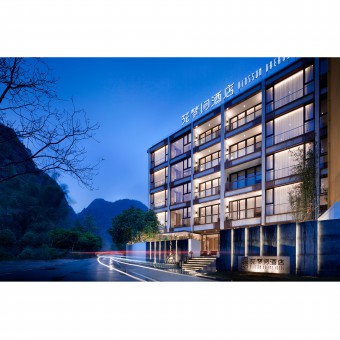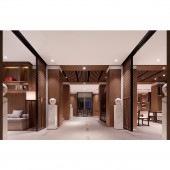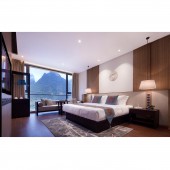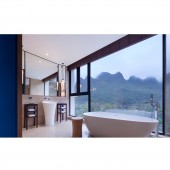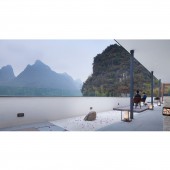DESIGN NAME:
Yangshuo Blossom Dreams Hotel
PRIMARY FUNCTION:
Hotel
INSPIRATION:
Borrowing from the concept of Chinese garden, the courtyard was surrounded by bamboo forest of three meters high, shaping levels and ensuring independence and privacy of the courtyard . On the south side of the hotel, there is an old building, in order to avoid its impact to the courtyard landscape, the bamboo there is increased to six meters high, acting as a perfect barrier.
UNIQUE PROPERTIES / PROJECT DESCRIPTION:
Blossom Dreams Hotel selected the site of its first boutique hotel in Xiatang, Yangshuo, which is among dreamy mists and flowers, fitting the leisureliness of soul. The overall design of the hotel combines historical and cultural elements, which conveys sentiment in scene and returned to the original nature.
OPERATION / FLOW / INTERACTION:
Design began in a four-sided transparent blank frame, and the designers started from the building to make a comprehensive design planning and transformation from the landscape to the interior and decoration. Building facade adopted white texture coating with rhythmic wood grain grille, forming a coordinated sequence with traditional aesthetic and holiday atmosphere.
PROJECT DURATION AND LOCATION:
The project is completed in November, 2016 in Yangshuo, Guilin, Guangxi Province, China.
FITS BEST INTO CATEGORY:
Interior Space and Exhibition Design
|
PRODUCTION / REALIZATION TECHNOLOGY:
Main Materials: Timber Veneer, Jade Lotus Marble, Black Brushed Stainless Steel, Wood Mold Concrete, Stone, Texture Paint
SPECIFICATIONS / TECHNICAL PROPERTIES:
The hotel has a total of twenty-six guest rooms, divided according to the different orientation landscapes and sizes. Designers extracted and applied representative regional colors for the guest room area to create different situational experiences, giving the space more natural spirituality and vitality. Large French windows bring the natural landscape into the interior space, achieving a panoramic view of the scenery by the window. Simple and elegant design is extented to the interior space, where the combination of contemporary design concept and humble objects form a visual collision and conflict, expressing sentiment by objects and giving space soul. Equipped with intelligent system and warm atmosphere lighting, the rooms provide more comfort than artistic conception.
TAGS:
hotel, interior design, historical, cultural element, contemporary
RESEARCH ABSTRACT:
Symmetrical design techniques is used for the lobby to convey the order aesthetics of new Chinese style. Simple lines are full of modern and fashion sense, which meet the contemporary aesthetic manner while bringing tradition to building. Elegant and low-key wooden materials were used to create a book bar and a tea room, showing a quiet spirit. Hollow screen is in harmony with light and shadow, exuding the elegant oriental temperament.
White space is the essence of traditional Chinese art, which pursues the combining of nihility and reality, thus creating wonderful environment. Integrated into the interior design, white space can not only broaden the level of space layout, but also emphasize the construction of artistic atmosphere. Regional characteristics were cleverly integrated in the creation of the scene, emphasizing the power of culture in space.
CHALLENGE:
On the top floor of the hotel there is a viewing courtyard, where endless mountain scenery in the clouds can be viewed. Elegant and quiet atmosphere brings peaceful imaginative space, which is the harmony between human and nature. Such scenery is enough to make people integrated in nature both physically and mentally, wandering among culture, away from the hustle and bustle, and enjoying the freedom of mind. Enjoy leisurely dream of blossom.
ADDED DATE:
2017-03-06 10:07:35
TEAM MEMBERS (1) :
Xiaolin Jiang
IMAGE CREDITS:
Image #1: Photographer Xufeng Jing, Yangshuo, 2016.
Image #2: Photographer Xufeng Jing, Yangshuo, 2016.
Image #3: Photographer Xufeng Jing, Yangshuo, 2016.
Image #4: Photographer Xufeng Jing, Yangshuo, 2016.
Image #5: Photographer Xufeng Jing, Yangshuo, 2016.
|



